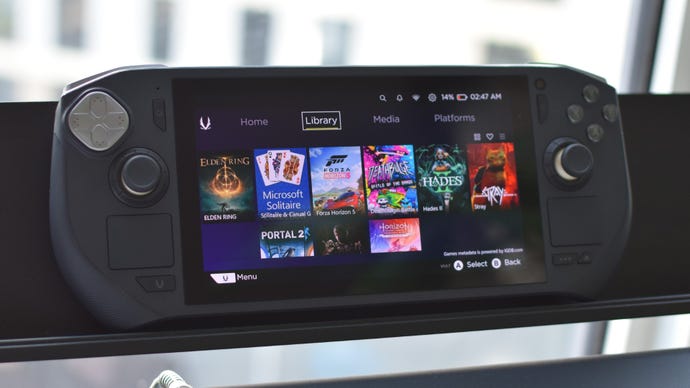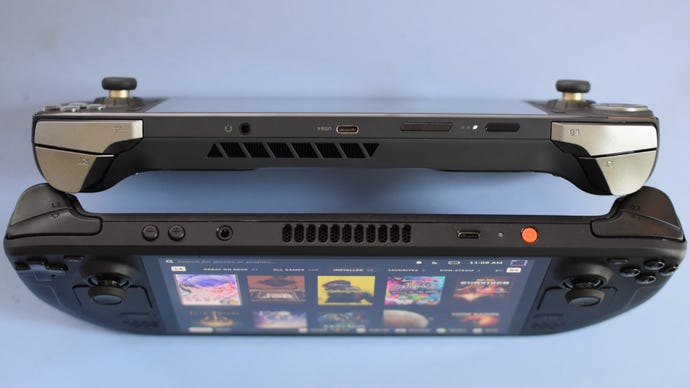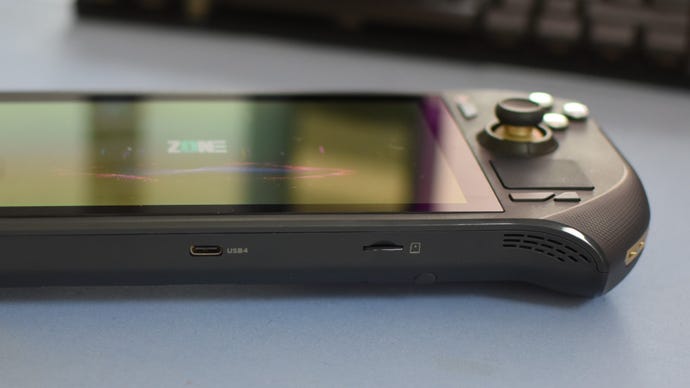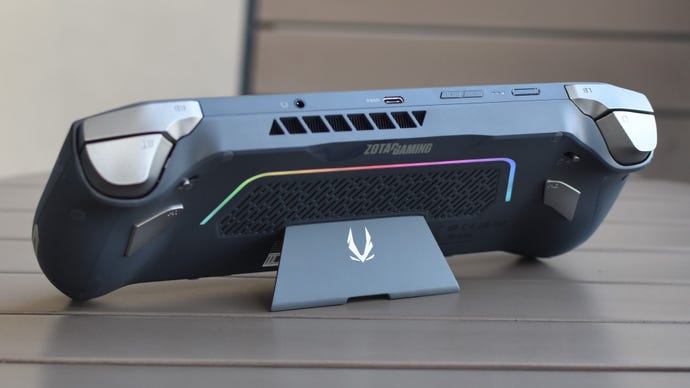Products You May Like
Zotac are one of the better graphics card makers of the post-EVGA era, so even as the early pangs of handheld gaming PC fatigue start to creep in, I’ve been keeping a hopeful eye on the Zotac Zone. This is their take on a Steam Deck rival, or more specifically, the Steam Deck OLED, as this is the first real competitor to go for a similarly star-bright, colour-erupting AMOLED display. Cor, phwoar, and indeed, wowzers.
Much like a Zotac GPU, the Zone is chunkier than you might like but ultimately well-crafted. It successfully combines that rich screen with oodles of input features and Deck-thrashing performance, though between its high price and a downright vampiric thirst for battery juice, it’s definitely more of a specialist tool than a crowd-pleasing portable.
This is, at least, by design. Take the controls: the pleasantly concave, Hall effect thumbsticks, mechanically clicky D-pad, and adjustable triggers could all have been lifted from a fancy top-end ‘pro’ gamepad like the Xbox Elite Wireless Controller or Razer Wolverine V3 Pro. These alone give the Zone a calibre of input quality and flexibility that’s currently unique among handheld PCs, and then it goes even further by adding dual trackpads. Indeed, just like on the Steam Deck, except these have real right/left-click mechanisms, instead of faking them with haptics as Valve do. More importantly, rubbing them in tandem makes it far easier to navigate Windows 11 on the Zone than on the thumbstick-only Asus ROG Ally and ROG Ally X, or even the single-padded Lenovo Legion Go.
Another clever little detail is the radial dials around each stick, which can be set to quickly adjust screen brightness, speaker volume, or the brightness of the RGB strip on the rear. All of these can be adjusted by other means, including with the actual volume buttons on the top, though being able to make these changes without moving either hand from their normal gripping positions is genuinely quite handy. My only complaint it that I wish these dials could control more, like thumbstick and trackpad sensitivity.

Granted, not all of the Zone’s features are as reliably useful. I’m not sure why there’s a webcam here, nestled up by the face buttons, unless you fancied running some kind of low-quality livestream with an unflatteringly angled facecam. And the hidden cost of stuffing in all these extra bells, whistles, and full-on tubas is that the Zone is noticeably heavier than the 640g Steam Deck OLED – my scales put it at a dense 714g, even more than the 692g figure given in the official specs. It’s thicker than the Deck as well, though not quite as wide.
Still, this substantial feel extends to the build quality, and I suppose some extra millimetres to the depth will allow the main chip – a laptop-style AMD Ryzen 7 8840U – more room to breathe. While not as whispery as the Deck OLED, the Zone’s mid-game fan noise is easily drowned out by the speakers, and the hand grips never become particularly warm to the touch.
Building a handheld around a laptop processor like this, as opposed to a purpose-built mobile APU, can be a tricky business. MSI tried it with the Claw, and despite an excellent product name (the Clawwwww), its Intel CPU proved so mismatched for the task that they stopped sending around review kits and quickly announced a reworked successor. Where games performance is concerned, however, the Zone appears to have got it right, its integrated Radeon 780M graphics pulling the best benchmark results in its class.
Even comparing the Zone’s 1080p results to those of the 800p Steam Deck, it either outpaces or practically matches the latter, and at a lowered 720p, Zotac simply has the fastest handheld of the whole bunch. Even the ROG Ally X, with its jacked-up 24GB memory supply, can’t keep up.
This extra power also enables games that can only just keep above 30fps on the Steam Deck to either run smoother on the Zone, or to remain playable with higher quality settings. Metaphor: ReFantazio, to name one, needs almost every setting on its lowest for the Deck to handle 30fps at 800fps; on the Zone, it typically stays above 35fps on Intermediate quality, despite the added strain of 1080p. This resolution is a bit too much for the demands of Horizon Forbidden West, but at 720p, it can still keep above 30fps with a mix of Low quality and FSR 3.1 on Performance mode – or 45-60fps with frame generation enabled on top. The Steam Deck OLED needs FSR on its considerably uglier Ultra Performance setting to even have a hope of 30fps.

Sadly, the Zone isn’t so much of a performance upgrade that it will run absolutely anything. PC-brutalisers like Warhammer 40,000: Space Marine 2 and the Silent Hill 2 remake won’t reliably meet the 30fps minimum at 720p, regardless of how much fuzzy upscaling you throw at them. Perhaps games like these are the next frontier for handhelds; the mountains that Valve are waiting for a “generational leap” to clear. In the meantime, though, there is value in simply being able to run light and middleweight games are tangibly quicker speeds, especially when the Zone’s 120Hz refresh rates makes it easier to appreciate the enhanced slickness.
Speaking of screens, the Zone’s display isn’t just sharper and faster than the Deck OLED’s, but bolder too. If only marginally: I recorded it covering 100% of the sRGB gamut, basically meaning it can show more colours than with the 93.8% coverage of Valve’s handheld. Balancing this out is the Deck OLED’s slightly higher peak brightness, of 984cd/m2 to the Zone’s 916cd/m2, while both get the Infinity:1 contrast ratio inherent to OLED displays.
The Zone still claims an overall specs win, by virtue of its higher resolution and refresh rate, but it’s a close-run contest on general usability. Firstly, the Steam Deck OLED’s screen has a much more effective anti-glare coating, making it more comfortable to peer at in direct light. Second, the Deck handles HDR an awful lot better, auto-enabling it when launching a compatible game but leaving it off otherwise. Since the Zone is a Windows machine, playing HDR games first requires that you manually dig into the display settings to switch on Windows HD Colour. Which – because Microsoft have never figured out otherwise – butchers the appearance of all non-HDR content until you disable it again. Even sillier than that, though, is how the Zone only allows for HDR in the first instance when it’s plugged in and charging – so this feature is off the table entirely on battery power. Which, for an expressly portable device, is kind of defeating the point.

The Deck OLED does software better in general, really. That’s not to discount how Windows will natively work with all game launchers and anti-cheat systems, a minority of which the Deck family still has trouble with, but the overall SteamOS experience remains more pleasant and painless than using Windows on a handheld. Yes, even with the extra trackpads. Those do help with clicking and scrolling, but you’re still ultimately trying to wrestle an OS built for desktop monitors into a dinky 7in device, and that’s never going to be feel as intuitive or even responsive as the totally bespoke, gamepad-tuned SteamOS.
The Zone gets a little help from Zotac’s ONE utility, which – similarly to Armory Crate on the ROG Ally – pulls in both a combined launcher for games and game platforms, and a Zone-specific set of tools, settings, and overlays. Some of it is useful, such as the easy-to-use input rebind menu, but it also offers nothing that SteamOS (or indeed, Armory Crate) does. Quite a bit less, in fact. Hit the overlay button while playing a game, and the sparseness of switches and toggles will make the SteamOS equivalent look like the Large Hadron Collider’s control room.
What’s worse are the bugs. The Zone isn’t as much of a misbehaving software safari as the ROG Ally X was at launch, but I did suffer a recurring problem where the display would simply neglect to.. display certain games. This started from launch with Horizon Zero Dawn, and in Silent Hill 2, everything worked fine until I tried swapping the resolution to 720p – for which I was punished with an unbudging black screen and some mocking menu music that confirmed the game was otherwise still running. Hopefully this can be fixed on Zotac’s end, as restarting and reinstalling graphics drivers didn’t help a jot.

This has become a common theme with Steam Deck alternatives: they’re usually faster, and come packing a wider range of hardware features, and yet they rarely end up feeling as practical to use. That goes for battery life too, unfortunately. Unlike both the original and OLED Steam Decks, the Zone evidently doesn’t know to stretch its lifespan when running less demanding games: with the speakers and screen brightness both on 50%, I got 1h 44m out of Forza Horizon 5, 1h 49m out of Elden Ring, and 1h 47m out of Portal 2. Points for consistency, but I’d much rather take a Steam Deck OLED on a long flight, as that managed 5h 48m in Portal 2, as well as 2h 14m in the hungrier Elden Ring. The ROG Ally X can handily outlast the Zone too, scoring 2h 55m in Forza.
I don’t wish to sound like I’m boiling a handheld’s entire appeal down to solely its battery life, but these are meant to be portable machines, so we can’t really understate the importance of endurance either. And the Zone isn’t even especially good for wired use, as the bundled USB-C charging cable is so short that the only way you could play it while topping up is if your chair is right next to a power outlet. Which makes HDR an even less likely proposition, too.
You also don’t get a case, which for a package costing £850 a pop – £50 more than the ROG Ally X, and nearly £400 more than a base Steam Deck OLED – is just mean. The Zone’s chart-topping game performance and premium inputs do mean it will beat any allegations of daylight robbery, but also, uh, oof? £850 is crème de la crème money, and on software and battery life, the Zone is more like a semi-skimmed Cravendale.
Its performance and controls, on the other hand, really are top-notch, and despite some HDR woes the AMOLED panel still makes a superb screen for general purpose play. So what to make of it?

Ultimately, that comes down to how you weigh each side of the framesrate-versus-practicality tradeoff. There are, I’m sure, people out there who’ve been left cold by the brawniness of portable PCs thus far – so the Zone, being as capable of outmuscling the Steam Deck and ROG Ally X as it is, could be the one they’ve been waiting for. Even if the handheld that burns twice as bright burns half as long.
The Steam Deck OLED, meanwhile, is the more balanced option. It’s not that fast, no, but it is close to half the price of the Zone while being easier to use, and for far longer periods. And while that’s probably the most tepid conclusion I’ve ever written for anything, this is like the fourth “pricier than a Steam Deck but faster and fancier” handheld PC review I’ve done, and there are only so many different ways of saying that. Maybe that’s where the fatigue comes from?
